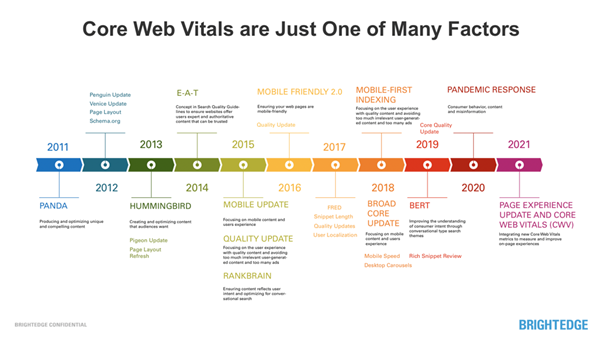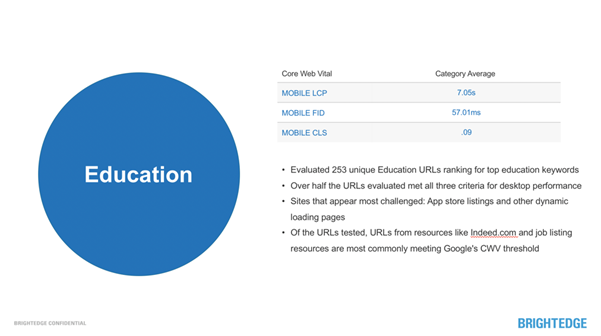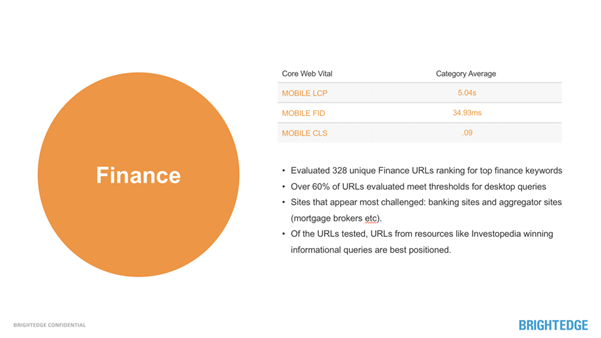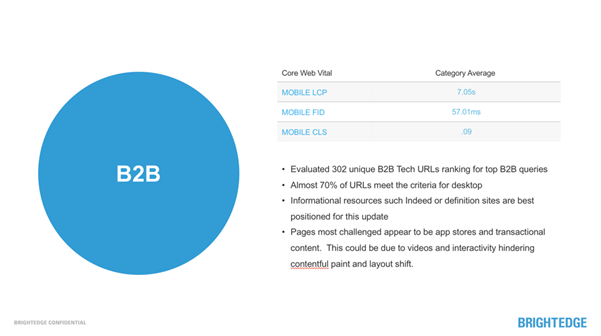Mobile-first and Core Web Vitals: connecting the dots for page experience success
As of March, some industries are more prepared than others when it comes to Google’s forthcoming Page Experience Update and Core Web Vitals guidelines
As of March, some industries are more prepared than others when it comes to Google’s forthcoming Page Experience Update and Core Web Vitals guidelines
The long-awaited implementation of mobile-first indexing is now upon us, meaning that content visible only on desktop will be ignored from this point on by the world’s largest search engine. Mobile-first has been a priority of Google’s for years as the beat of the user experience drum has grown to a crescendo.
A few short months from now, the Page Experience update as a whole will roll out, too. Page experience “measures aspects of how users perceive the experience of interacting with a web page,” according to Google and consists of five major Search signals.
Hopefully you’re familiar with at least four of these, as they’ve been in play for some time. Mobile-friendliness, safe-browsing, HTTPS-security, and intrusive interstitial guidelines have each been rolled out and updated as Google has sought to keep pace with evolving consumer expectations.
So what’s new?
In May, signals from a new metric called Core Web Vitals (CWV) will combine with these existing four signals for one mega-metric called Page Experience. BrightEdge (my company) conducted a study into CWVs preparedness and mobile-first compliance to determine the potential impact on sites in four major industries. But first, it’s important to understand the CWV opportunity and the relationship between this new set of metrics and the mobile-first index.
Before we go any further, note that CWVs are not a guideline that could instigate a penalty if not followed. Cloaking is one such example of a violation of Google’s Webmaster Guidelines, and if you’re caught out at it you run the risk of being penalized by Google.
Core Web Vitals, on the other hand, is an opportunity. If you fail to meet the thresholds for each of the three major areas of focus that make up the CWV signal, you won’t get a penalty. But you will miss out on the rankings boost available to those who meet the standards.
And what are those standards?

Meeting one of two of these goals won’t suffice; Google has confirmed that all three must be met in order to see the rankings boost available via CWV. You can read more about these important metrics here.
Safe browsing, HTTPS security, and intrusive interstitial guidelines are fairly straightforward — you’re either in line with the guidelines or you’re not.
Mobile-first and Core Web Vitals are more complex, consisting of a greater volume of moving parts, and therefore are getting the lion’s share of webmaster attention as the May rollout looms. Hosting, site structure, image optimization, and more can all impact how your site loads on mobile. James Parsons recently shared a 28-point checklist of optimizations to work through as you’re preparing for CWVs that every webmaster and SEO should check out.

Mobile-first has an outsized impact due to its influence on local search experience, as well. Considering that 60 percent of mobile searches have local intent, the vast majority of businesses cannot afford to ignore Google’s emphasis on the mobile index. When local consumers are out in their neighborhoods searching for nearby businesses to meet their needs, it’s imperative that the website loads lightning-fast.
So how are businesses doing at preparing for the Page Experience update? BrightEdge (my company) recently conducted research that compared top sites in different industries to see how vulnerable each is to the May update. We currently have no way to gauge just how impactful the introduction of CWVs to the ranking algorithm will be, and so wanted to both explore preparedness and establish a baseline.
Here’s what we found.
We analyzed over 1,500 URLs across four industries for the purpose of this study:
Rather than using the homepage, we selected the URLs responsible for driving organic traffic for each site. For each webpage, we measured Share of Voice for the top 500 keywords in each industry, analyzed mobile page speed performance using the Crux database, and evaluated adherence to Core Web Vitals using the parameters:
As it turns out, some industries are better prepared than others for the Page Experience update, as reflected in these findings of what percentage of URLs would receive the Core Web Vitals rankings boost if it rolled out today:
As you can see, there are massive seats at the table for brands that act now to get in line with this impending update. First-movers will enjoy the benefits of this ranking boost when it hits. The full findings can be found here.
Here are some of our findings by industry.





It is worth mentioning that in retail, multiple product listings from the same domains dominated share of voice, resulting in a higher proportion of retail URLs being tested. We did not see a single example of major online retailers (Amazon, Target, and the others) winning a share of voice with their homepages – rather, their organic traffic is being fueled by product and category pages.
We hypothesize that page attributes such as hero images of products and promotional pop-ups are driving non-compliance for the largest contentful paint and layout shift.
Core Web Vitals signals and the larger Page Experience set of metrics are sure to be impactful, but they are among many signals that indicate to Google that your webpage offers a safe, positive, and useful experience for the searcher. This is the heart and soul of every update Google makes and should therefore be the driving force in your SEO strategy.
Keep these findings in mind as you prepare for the Page Experience update and implementation of Core Web Vitals as Google ranking signals:
Enterprise digital marketers and SEOs must work now on the right course of action to meet core vital benchmarks, so they are not left behind. How you communicate the potential impact of this upcoming shift to decision-makers to win buy-in is key.